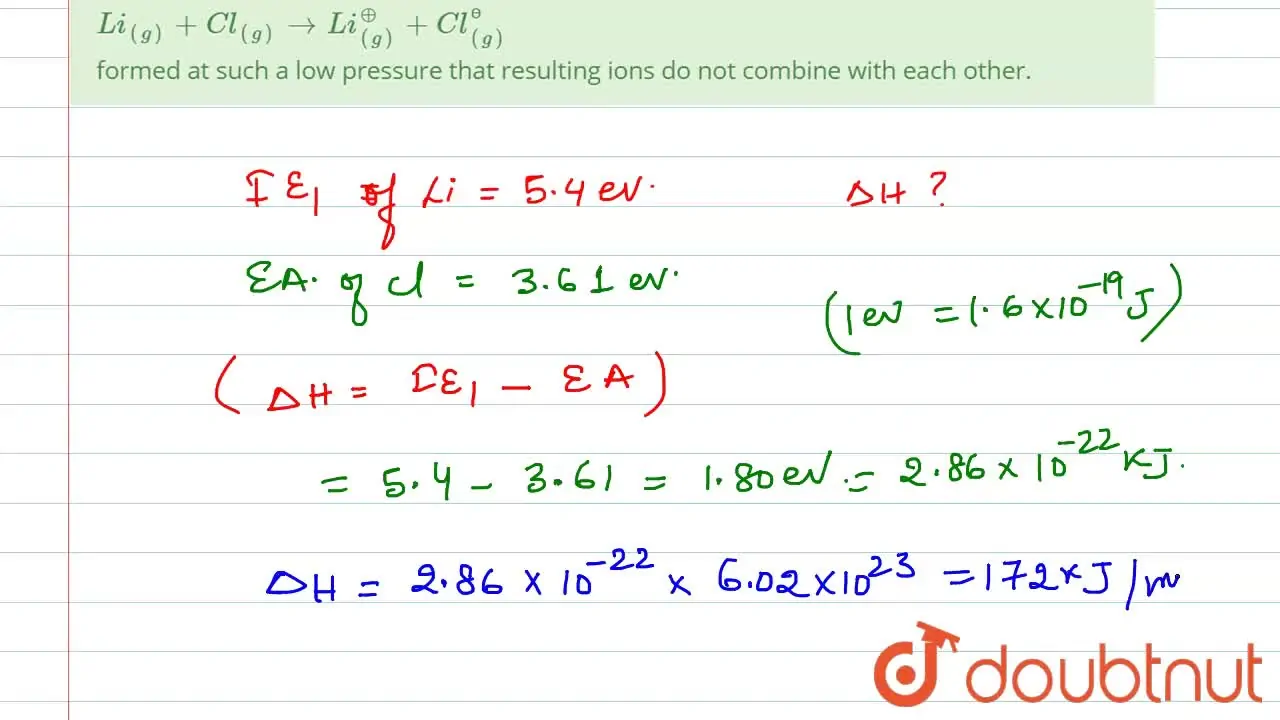Answer the following question (Based on EA,ΔegHɵ and IE).
IE1 of Li is 5.4eVatom−1 and the EA of Cl is 3.6eVatom−1. Calculate ΔrHɵ in kcal mol−1 and kJmol−1 for the reaction
Li(g)+Cl(g)→Li⊕(g)+Clɵ(g)
formed at such a low pressure that resulting ions do not combine with each other.
(a) Li(g)→Li⊕(g)+e−, IE1=5.4eVatom−1 …(i)
Cl(g)+e−Clɵ(g), EA1=−3.6eV=−3.6eVatom−1 …(ii)
Note: EA1 is negative.
Adding Eqs. (i) and (ii), we get
Li(g)+Cl(g)→Li⊕(g)+Clɵ(g)
∴ΔrHɵ=IE1+EA1=5.4+(−3.6)=1.8eVatom−1
We know 1eVatom−1=23.06kcalmol−1 and 1eVatom−1=96.49kJmol−1
∴ΔrHɵ (in kJmol−1) =1.8×23.06
=41.508kJmol−1
∴ΔrHɵ (in kcalmol−1) =1.8×96.49
=173.682kcalmol−1
(b) EN of X=IE+EA125 (when IE and EA values are in kcalmol−1)
=400+80125=3.84
EN of Y=300+85125=3.08
∴EN of X>EN of Y
(e) S(g)+e−→Sɵ(g),EA1=−200kJmol−1
Sɵ(g)+e−→S2−(g),EA2+649kJmol−1
The addition of the second electron to Sɵ(g) experience repulsion from the already present electrons.
(d) i. Cl. When electron is added to F, the added electron goes to smaller n=2 (i.e., 2p orbital) quantum level and suffers significant repulsion from the other electrons present in the shell. So, electron is being added with difficulty in F than in Cl. Hence less negative energy in released in F than in Cl. So, ΔegHɵ of F is less negative than Cl.
(ii) F.ΔegHɵ of F is more negative then O due to the small size of F than O. Moreover, ΔegHɵ increases (more negative) along the period (→).
(e) e−+O(g)→Oɵ(g)EA1=−200kJmol−1
e−+Oɵ(g)→O2−(g),EA2=?
EA2 is positive sue to move electrons-electron repulsion.
(f) Due to the compact nature of oxygen atom it has less negative ΔegHɵ(−14kJmol−1) than S(−200kJmol−1). [Same explanation as in ΔegHɵ of F and Cl].
Related Playlists
- BOOK - CENGAGE CHEMISTRY ENGLISHCHAPTER - PERIODIC CLASSIFICATION OF ELEMENTS AND GENERAL INORGANIC CHEMISTRYEXERCISE - Ex 1.114videos
PERIODIC CLASSIFICATION OF ELEMENTS AND GENERAL INORGANIC CHEMISTRY
- BOOK - CENGAGE CHEMISTRY ENGLISHCHAPTER - PERIODIC CLASSIFICATION OF ELEMENTS AND GENERAL INORGANIC CHEMISTRYEXERCISE - Ex 1.1 (Very Short)22videos
PERIODIC CLASSIFICATION OF ELEMENTS AND GENERAL INORGANIC CHEMISTRY
- BOOK - CENGAGE CHEMISTRY ENGLISHCHAPTER - PERIODIC CLASSIFICATION OF ELEMENTS AND GENERAL INORGANIC CHEMISTRYEXERCISE - Exercises (Archives )Subjective4videos
PERIODIC CLASSIFICATION OF ELEMENTS AND GENERAL INORGANIC CHEMISTRY
- BOOK - CENGAGE CHEMISTRY ENGLISHCHAPTER - P-BLOCK GROUP 14 - CARBON FAMILYEXERCISE - Exercises Archives (Subjective)9videos
P-BLOCK GROUP 14 - CARBON FAMILY
- BOOK - CENGAGE CHEMISTRY ENGLISHCHAPTER - PURIFICATION OF ORGANIC COMPOUNDS AND QUALITATIVE AND QUANTITATIVE ANALYSISEXERCISE - Assertion Reasoning Type5videos
PURIFICATION OF ORGANIC COMPOUNDS AND QUALITATIVE AND QUANTITATIVE ANALYSIS
Similar Questions
If the first ionization enthalpy of Li is 5.4 eV and the elec- tron gain enthalpy of chlorine is 3.6 eV then the ΔH in kcal/mole for the reaction will be
Li(g)+Cl(g)→Li+(g)Cl−(g) (Presume that the pressure is so low that the ions do not combine with each other)View SolutionCalculate ΔH∘ (inkJmol−1) for the reaction
CH2Cl2(g)→C(g)+2H(g)+2Cl(g).
The average bond enthalpie of C−H and C−C1 bonds are 414kJmol−1.View SolutionThe IE1 of Li is 5.4eV and IE1 of H is 13.6eV. Calculate the charge acting on the outermost electron of Li atom.
View SolutionFor the reaction, A(g)+B2(g)→AB2(g),δS=110JK−1mol−1,δH=55kgmol. Reaction will be spontaneous at
View SolutionΔGɵ for 12N2(g)+32H2(g)⇔NH3(g) is −16.5kJmol−1. Find out Kp for the reaction at 25∘C.
View SolutionFor the reaction : C2H5OH(l)+3O2(g)→2CO2(g)+3H2O(g)
if ΔU∘=−1373kJmol−1 at 298K. Calculate ΔH∘View SolutionThe amount of energy released when 1012 atoms of Cl vapours are converted to Clɵ ions, according to the equation :
Cl(g)+e−→Clɵ(g) is 58×10−10J
Calculate the ΔegHɵ of Cl atom in kJmol−1 and eVatom−1.View SolutionGiven below are the values of ΔHɵ and ΔSɵ for the reaction given below at 27∘C.
SO2(g)+12O2(g)→SO3(g)
ΔHɵ=−98.32kJmol−1,ΔSɵ=−95Jmol−1
Find Kp for the reactionView SolutionDetermine enthalpy change for the reaction,
CH4(g)+Cl2(g)→CH3Cl(g)+HCl(g)
Bond energies for C−H,C−Cl,Cl−Cl,H−Cl are 412,338,242,431kJmol−1 respectively.View SolutionΔH∘1 for CO2(g), CO(g) and H2O(g) are −393.5,−110.5 and −241.8kJmol−1 respectively. Standard enthalpy change for the reaction
CO2(g)+H2(g)→CO(g)+H2O(g) isView Solution


